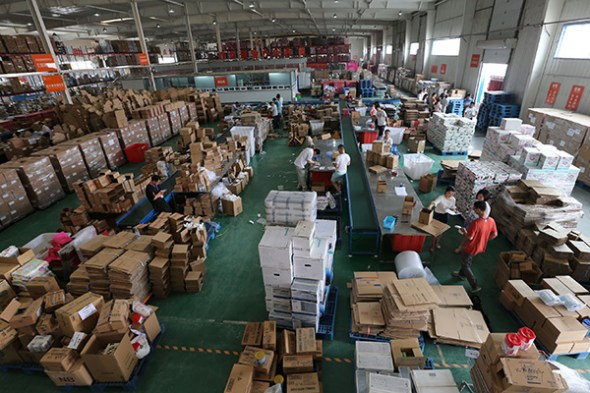
Workers packed the imported goods in Zhengzhou Cross-border E-commerce Center, Central China's Henan province, May 29, 2015. Zhengzhou is one of the pilot cities for import e-commerce in China. (Photo/Xinhua)
Every afternoon, Cao Fuchun goes to a nearby express delivery station to see if any parcels have arrived for him. The retired worker has caught the "overseas" bug.
For Cao, buying goods online from overseas means he can shop in countries he has never been to. Living in Pengzhou county near Chengdu, Southwest China's Sichuan province, Cao has bought skimmed milk from Australia, beef from Argentina and a water filter from Germany, among other goods.
At the end of last year, Cao's daughter, an accountant in Beijing, bought US-made fish oil capsules and vitamin tablets for her parents. "I was surprised how inexpensive they were, so I got hooked on buying overseas," he says.
A growing number of Chinese online shoppers are buying globally. Most are young, well educated and eager to buy foreign goods that are unavailable or exorbitantly priced in China. They are a booming multi-billion-dollar market for foreign e-retailers and producers.
According to the China E-commerce Research Center, China's total cross-border e-commerce-inbound and outbound-reached 4.2 trillion yuan ($657 billion) in 2014, and will grow to 5.5 trillion yuan in 2015.
The Ministry of Commerce forecasts cross-border e-commerce will be worth 6.5 trillion yuan in 2016, accounting for 20 percent of the country's total foreign trade.
Nielsen's Global E-commerce and The New Retail Survey in April said several factors are at play to boost China's e-commerce. Rapid urbanization and high population density make the home delivery model economically viable, particularly when coupled with low labor costs. In addition, booming smartphone ownership and usage have created huge mobile commerce opportunities.
China's domestic e-commerce sector is gaining its share of the market, too. According to China's Customs service and China E-commerce Research Center, 18 million Chinese spent 140 billion yuan buying from overseas in 2014, and that is expected to reach 1 trillion yuan in 2018.
The government is backing this trend. In August 2013, the State Council issued a policy to support cross-border e-commerce, with six concrete measures to facilitate processes, including Customs clearance, quarantine inspection, duties and foreign exchange.
In 2014, seven cities-Shanghai, Hangzhou, Ningbo, Zhengzhou, Guangzhou, Shenzhen and Chongqing-were designated import e-commerce pilot zones, where foreign goods can be stored in bonded warehouses before Customs clearance. In 2015, another two coastal cities were added to the list.
According to tax regulations in those cities, each order under 500 yuan is duty-free, and each order from 500 to 1,000 yuan incurs a 10-percent tariff, compared with ordinary imported goods being taxed around 40 percent on average.
Some pilot cities have also simplified their Customs regulations. In Guangzhou, e-retailers can immediately register overseas goods with Customs when a Chinese buyer makes a deal, so tariff collection and other procedures are faster. On Nov 11, the 22nd Asia-Pacific Economic Cooperation Economic Leaders' Meeting in Beijing supported the trade with the APEC Cross Border E-Commerce Innovation and Development Initiative.
For e-commerce giant Amazon and its competitors, including Alibaba, new opportunities have opened since last year.
On Aug 20 last year, Amazon China announced it would begin cross-border online shopping in the Shanghai Free Trade Zone. Chinese buyers could go to Amazon websites in the US and other countries to buy online and receive shipments in a week to 10 days with lower delivery costs.
Amazon has tactically changed the "proxy" mode of overseas online shopping, whereby a Chinese buyer pays a proxy to buy goods abroad, and the proxy dispatches the goods as personal items.
The proxy mode has several risks, such as fake goods provided by the proxy, delivery delays, and documentation and tax issues during Customs clearance.
Amazon's bonded warehouses mode is easier and cheaper. With the help of data collected over the years, Amazon can forecast orders and send goods in advance by sea to Shanghai Free Trade Zone bonded warehouses. Amazon sends the items from Shanghai after a Chinese buyer makes a purchase.
Big players in China's e-commerce sector, such as Alibaba and 360buy, have followed Amazon to open overseas channels. They cooperate with foreign retailers to sell seafood from Alaska, avocados from Mexico, or even million-yuan jetpacks designed in New Zealand. Many e-commerce companies also use bonded warehouses to import mass consumption goods, such as infant formula powders, diapers, vitamin pills and cosmetics.
Improved logistics and supply systems will further unlock overseas market potential. According to the 2015 China Cross-border Online Buyer Report issued by Internet industry consultancy iResearch, only 15.3 percent of online shoppers have bought from overseas. They chose foreign-made commodities because of better quality (67.8 percent) and price (65.5 percent), and because goods are unavailable in China (52 percent).
Chen Fengying, head of the World Economy Research Center at the China Institutes of Contemporary International Relations, says overseas shopping will boost the world economy and create jobs abroad.
"We are now not only makers, but also buyers. A growing part of China's 1.3 billion population is entering the middle class with surging demand. It is the whole world's opportunity."


















































